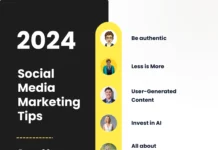In today’s digital landscape, social media platforms have become a cornerstone for driving website traffic. Businesses, large and small, have tapped into the vast audiences of Facebook, Instagram, Twitter, and other social networks to boost visibility and engagement. While social media can be a powerful tool for connecting with potential customers, its volatile nature—characterized by changing algorithms, shifting user preferences, and occasional privacy concerns—makes relying on it a risky strategy. This precarious dependence underscores the importance of diversifying traffic sources. By exploring and investing in alternative avenues for traffic acquisition, businesses can mitigate risks, enhance their reach, and ensure a more stable and consistent flow of visitors to their websites.
Diversification not only secures a business against the whims of social media trends but also opens up opportunities to connect with different audience segments that might not be as active on social media. To effectively tap into these varied sources, adopting a multi-channel approach is crucial. This strategy involves integrating different marketing channels—such as search engine optimization (SEO), search engine positioning, email marketing, content marketing, and pay-per-click (PPC) advertising—into a cohesive plan that drives traffic from multiple fronts. An effective multi-channel approach increases the potential touchpoints for engaging with customers and enhances the customer journey by providing multiple pathways to your digital doorstep.
In this article, we will explore several key strategies to drive website traffic beyond social media and offer actionable tips and insights into how businesses can broaden their digital marketing efforts to build a more resilient and dynamic online presence.

How Can SEO Enhance Your Website’s Visibility and Organic Reach?
Search Engine Optimization, or SEO, is a fundamental digital marketing strategy aimed at improving the visibility of a website in search engine results pages (SERPs). By optimizing a website according to the criteria favored by search engines like Google, businesses can increase organic (non-paid) traffic, which often leads to higher engagement and conversion rates.
Keyword Research:
The foundation of SEO is keyword research. Identifying and targeting the right keywords is essential for attracting the intended audience. Businesses should focus on keywords that are relevant to their products or services, with a good balance of search volume and competition. Tools like Google Keyword Planner, SEMrush, or Ahrefs can provide insights into the keywords your audience is searching for, allowing you to tailor your content to meet those needs.
On-Page SEO Tactics:
On-page SEO is crucial for ensuring that each page of your e-commerce website is tailored to meet the needs of both search engines and users. Let’s take the example of an e-commerce site selling shoes to analyze what on-page strategies can be particularly effective:
Content Quality:
Ensure that product descriptions for your shoes are detailed, engaging, and helpful. Highlight features such as material, design, comfort, and care instructions. Use language that answers common customer queries, like “best shoes for summer hikes” or “comfortable office footwear,” ensuring that your content aligns with what potential customers might be searching for.
Meta Tags:
Use the title tags and meta descriptions as a concise sales pitch for each page. For a product page, this could be something like “Buy Stylish Men’s Running Shoes | Free Shipping,” which includes keywords like “buy,” “men’s running shoes,” and “free shipping.” Make sure the meta description provides a compelling reason to click, such as highlighting unique features or a special promotion, e.g., “Explore our durable and lightweight men’s running shoes perfect for enhancing your performance. Shop now for exclusive discounts and free shipping!”
Images:
Optimize your images to attract both users and search engines. Use clear, high-quality images of the shoes from multiple angles. For image file names and alt tags, use descriptive keywords that relate directly to the shoe’s features, like “women-leather-boots-black.jpg” and alt=”Women’s Black Leather Boots Side View.” This helps in image search results and improves accessibility for users who rely on screen readers.
URLs:
Design URLs to be informative yet straightforward, incorporating key terms that reflect the product’s content. For example, a URL like “www.example.com/mens-casual-sneakers” is optimal for a page featuring men’s casual sneakers. This boosts SEO and enhances user experience by making the URL easy to understand and remember.
By focusing on these on-page SEO tactics, your e-commerce site can improve its visibility and attractiveness in search results, drawing more potential customers looking to purchase shoes online.
Off-Page SEO Strategies:
Implementing effective off-page SEO strategies is vital for improving your site’s authority and attracting more customers from various online sources. Here’s how you can apply these strategies:
Building Backlinks:
- High-Quality Backlinks: Focus on acquiring backlinks from authoritative sites within the industry, namely the fashion and retail industry, if we’re using the same online shoe shop example. For example, getting a mention from a popular fashion blog or a review from a well-regarded footwear magazine can significantly boost your site’s credibility.
- Partnerships: Collaborate with other e-commerce platforms that sell complementary products (like shoe care products or clothing) and exchange backlinks through shared content or promotions.
Guest Blogging:
- Industry Blogs: Contribute articles to popular fashion and lifestyle blogs. For instance, writing a post on “Top 10 Shoe Trends for 2023” for a high-traffic fashion blog can introduce your brand to a broader audience. Ensure the content is useful and include a link back to a relevant page on your site that showcases the trends mentioned.
- Content Value: Focus on creating valuable content that addresses the needs of the blog’s audience, such as “How to Choose the Right Running Shoes” or “The Best Shoes for Every Type of Workout.” This will increase the likelihood of the blog’s audience visiting your website.
Influencer Collaborations:
- Social Media Influencers: Partner with fashion influencers who have a strong following on platforms like Instagram, YouTube, or Pinterest. For example, send a new line of eco-friendly sneakers to an influencer who promotes sustainable fashion. They can create posts or videos that showcase the benefits and styling of these sneakers, directing their followers to your website.
- Product Reviews and Unboxings: Encourage influencers to do detailed reviews or unboxing videos of your shoes. This provides exposure and builds trust when a respected figure validates the quality of your products.
- Giveaways and Promotions: Work with influencers to run contests where participants must visit your site and sign up for your newsletter to enter, thereby driving traffic directly to your site.
By leveraging these off-page SEO strategies, your e-commerce website can enhance its online presence beyond its pages, attracting traffic from diverse and authoritative sources, which can lead to increased sales and brand recognition.
Local SEO:
For an e-commerce website specializing in shoe sales, targeting local customers can be a significant advantage, especially if the business also has a physical storefront or a specific geographic focus. Here’s how to leverage local SEO effectively:
Google My Business (GMB):
- Setup and Optimization: Create a Google My Business listing if you haven’t already. Make sure all the information is accurate and complete, including your business name, address, phone number, and hours of operation. This is important for local searches and appears prominently in Google Maps and local search results.
- Regular Updates: Post regular updates about new arrivals, promotions, or events like local pop-up shops. For example, if your shoe store is launching a new line of winter boots, posting this on your GMB listing can attract local customers searching for winter footwear.
- Engagement: Encourage satisfied customers to leave positive reviews on your GMB listing. Respond to reviews to show that you value customer feedback, which can help improve your local search rankings and appeal to potential customers.
Local Citations:
- Directory Listings: Ensure your e-commerce store is listed in relevant local business directories. For a shoe store, this could include fashion and retail directories, local business groups, or commerce chambers. Ensure that your listing details are consistent across all platforms.
- Niche-Relevant Platforms: In addition to general local directories, list your business on niche-specific sites like fashion and footwear directories. For example, a listing on a local fashion blog’s directory or a regional retailer’s association website.
- Accuracy and Consistency: Regularly check your listings to ensure that all information is accurate and consistent. Inconsistencies in your business name, address, and phone number (NAP) across different directories can negatively impact your local search rankings.
By focusing on these local SEO strategies, your shoe store can increase its visibility among local shoppers, driving both online and foot traffic to your site and store. This targeted approach helps in building a strong local customer base, essential for sustained business growth in specific geographic markets.
Technical SEO:
Technical SEO enhances the backend structure of your site:
- Site Speed: Faster websites provide a better user experience and are favored by search engines. Tools like Google PageSpeed Insights can help identify ways to improve load times.
- Mobile-Friendliness: With the increase in mobile browsing, having a responsive design is imperative.
- Secure Connections: Implementing HTTPS ensures a secure connection, which is a ranking factor for Google.
What Role Does Content Marketing Play in Attracting and Engaging Website Visitors?
Content marketing is a strategic approach focused on creating and distributing valuable, relevant, and consistent content to attract and retain a clearly defined audience — ultimately, to drive profitable customer action. It revolves around providing users with content they find useful, which helps build brand loyalty and encourages engagement without overtly selling a product. If we take the example of a blog focused on coffee, utilizing a variety of content marketing strategies can significantly enhance traffic and engage a broader audience of coffee enthusiasts. Here’s how to leverage different types of content and distribution tactics:
Content as a Traffic Driver:
- Valuable and Relevant Content: Create content that offers value and relevance to your audience. For a coffee blog, this could involve articles that answer common questions (e.g., “What is the Best Temperature to Brew Coffee?”), tutorials (“How to Make a Perfect Espresso at Home”), and in-depth reviews of coffee machines or beans. Such content addresses the interests and needs of coffee lovers, drawing them to your blog for insights and advice.
Types of Content:
- Blogs: Regular blog posts on topics like the latest trends in coffee brewing or comparisons of different types of coffee beans.
- Ebooks: Comprehensive guides such as “The Beginner’s Guide to Coffee Varieties” can be offered as a download in exchange for email signups.
- White Papers: More detailed and data-driven content, such as a study on the impact of coffee consumption on productivity, appealing to a more academic or professional audience.
- Infographics: Visual content such as “The Coffee Lover’s Map of the World,” which showcases coffee culture around the globe, can be easily shared across social media platforms.
- Videos: Step-by-step brewing tutorials or day-in-the-life videos of baristas, which can be shared on YouTube and embedded in blog posts.
Content Distribution:
- Email Newsletters: Build an email list and regularly send out newsletters featuring new blog posts, tips, and exclusive offers or content. For instance, a monthly newsletter could highlight “This Month’s Best Coffee Recipes.”
- Industry Forums: Participate in coffee-related forums and discussion groups like Home-Barista or r/Coffee on Reddit. Share your expertise and content in discussions, which can drive traffic back to your blog.
- Social Media: Utilize platforms like Instagram for visually appealing content, such as latte art images or short brewing videos, linking to more detailed blog posts.
Repurposing Content:
- Refresh Old Content: Update older blog posts with new information, links, or images. For example, an article on “Best Coffee Shops in New York” can be updated yearly with new entrants and trends.
- Convert Content Forms: Turn a popular blog post into a video or an infographic. For instance, a well-received post on “The Science Behind the Perfect Cup of Coffee” could be turned into an engaging video tutorial.
- Create Series or Spin-offs: If a particular topic garners interest, expand it into a series. For example, a post on “How to Brew with a French Press” could lead to additional posts or videos on using other types of coffee makers, like AeroPress or drip.
By employing these content marketing strategies, a coffee blog can attract more visitors and build a loyal community of engaged readers who frequently return for more insightful and helpful coffee content.
How Does Email Marketing Contribute to Sustained Traffic Growth?
Email marketing is a powerful strategy for engaging customers, promoting products, and driving sales. This section will outline how to effectively implement and optimize email marketing tactics tailored to the needs of a drop shipping business.
Building an Email List:
- Ethical Collection Methods: Use sign-up forms on high-traffic pages such as your homepage, blog, and checkout page. Offer incentives like discounts or free shipping on the first order to encourage sign-ups.
- Pop-Ups and Landing Pages: Employ pop-up forms that trigger based on user behavior, such as time spent on the site or intent to exit. Also, create landing pages for special promotions where visitors can register for updates.
Email Campaigns:
- Personalized Content: Segment your email list by customer behavior—like past purchases—and send personalized recommendations. For instance, follow up a purchase of a camping tent with emails featuring related products like sleeping bags.
- Engaging Designs: Use attractive, mobile-friendly email templates with clear calls-to-action and high-quality product images.
Automation and Segmentation:
- Automation: Automate routine emails like welcome messages, order confirmations, and shipping updates to maintain consistent communication.
- Segmentation: Categorize your email list by criteria such as demographics or purchase history, and tailor campaigns to these segments. For example, target inactive customers with re-engagement discounts.
Measuring Success:
- Key Performance Indicators (KPIs): Monitor metrics like open rates, click-through rates, and conversion rates to evaluate your email campaigns’ success.
- A/B Testing: Test variations in your emails, such as different subject lines, to determine what works best.
Advanced Tactics:
- Behavioral Triggers: Deploy emails in response to specific actions, such as cart abandonment, with incentives to complete the purchase.
- Customer Feedback: Periodically send surveys to collect customer feedback, enhancing engagement and gaining valuable insights.
By employing these concise and effective email marketing strategies, your drop shipping business can strengthen customer relationships and boost sales.
Why is PPC a Quick Strategy for Boosting Website Traffic?
PPC, or Pay-Per-Click advertising, is a quick strategy for boosting website traffic because it allows advertisers to place their ads in front of a targeted audience immediately. By bidding on specific keywords relevant to their products or services, businesses can ensure their ads appear on search engine results or social media feeds, directly reaching those who are most likely to be interested. This direct approach bypasses the need for organic growth, making it possible to see an increase in traffic as soon as the campaign goes live.
For an e-commerce website selling handmade soaps, PPC can be a highly effective tool to drive targeted traffic and increase sales. Here’s how you can use PPC effectively for this type of business:
Google Ads:
- Keyword Targeting: Use specific keywords related to handmade soaps, such as “organic handmade soaps,” “artisanal soap gifts,” or “natural handmade soap.” These keywords can attract users who are actively searching for these products.
- Ad Copy: Create compelling ad copy highlighting your soaps’ unique qualities, such as “100% Organic Ingredients” or “Handcrafted with Care.” Include a call-to-action like “Shop Now” or “Discover Your Perfect Soap.”
- Landing Pages: Design landing pages that are directly linked from your ads. These pages should provide detailed information about the products featured in the ad and include images, benefits, customer testimonials, and an easy purchasing option.
Facebook and Instagram Ads:
- Visual Appeal: Use high-quality images or videos of your soaps to grab attention. Showcase their texture, ingredients, and the process of making them to convey their uniqueness and handmade quality.
- Targeting Options: Take advantage of Facebook’s extensive targeting options to reach specific demographics who may be interested in handmade soaps, such as those interested in natural skincare, wellness, or handmade goods.
- Promotions: Run promotions such as discounts or bundle offers in your ads to entice clicks and conversions.
Remarketing:
- Remarketing Campaigns: Implement remarketing campaigns to target users who have visited your site but have not made a purchase. Display ads that remind them of the products they viewed or offer them a special discount code to complete their purchase.
Seasonal Campaigns:
- Seasonal Promotions: Tailor your PPC campaigns to align with holidays or seasonal events. For example, create special Valentine’s Day or Mother’s Day ad campaigns featuring your soaps as ideal gifts. Use seasonal keywords and adjust your ad copy to match the holiday theme.
By implementing PPC advertising through strategic keyword selection, compelling ad copy, and targeted campaigns, your e-commerce website for handmade soaps can draw in more visitors who are likely to become customers.
How Do Partnerships, Networking, and Public Relations Expand Your Online Influence?
Partnerships, networking, and public relations are fundamental for expanding your online influence, especially for new business owners. You can significantly enhance your brand’s visibility by forming strategic partnerships with related but non-competing businesses, engaging in effective networking, and actively managing your public relations. Let’s use the same example of an e-commerce site selling handmade soaps and see how you could expand your reach.
Strategic Partnerships:
Collaborate with non-competing but related businesses, such as those selling bath accessories or natural beauty products, to create joint promotions or bundled deals that attract a broader audience.
Affiliate Marketing:
Implement an affiliate program where influencers and bloggers can promote your products for a commission. Use affiliate management platforms to oversee these partnerships and track their success.
Guest Posting:
Contribute articles to well-regarded industry blogs. Choose topics that highlight your expertise and relate directly to your products, such as the benefits of natural skincare ingredients.
Webinars and Workshops:
Host educational sessions like webinars or live workshops on topics like the art of soap making or the benefits of organic ingredients, which can be promoted via social media and email to draw participants.
Networking:
Actively participate in industry events and join relevant professional groups to meet potential partners, share ideas, and gain exposure.
Public Relations and Media Outreach:
- Press Releases: Distribute press releases about noteworthy aspects of your business, like innovative product launches or community engagements, to both local and national media.
- Media Relations: Build ongoing relationships with journalists and influencers who focus on your industry, providing them with unique insights and news to secure more extensive coverage.
- Event Sponsorship and Participation: Increase your visibility by sponsoring or participating in relevant events, which can direct more traffic to your website or storefront and enhance brand recognition.
By integrating these approaches, you can broaden your network, establish authority, and drive significant traffic and interest to your business. These combined efforts help create a strong presence in your market and open up various avenues for growth and exposure.
Conclusion:
In exploring alternative digital marketing strategies beyond social media, we’ve uncovered a wealth of options businesses can employ to drive website traffic, engage a broader audience, and ultimately boost sales. From leveraging the precision of SEO to harness the reach of content marketing and from harnessing the immediacy of PPC to cultivating lasting relationships through strategic partnerships and public relations, the opportunities for diversifying traffic sources are extensive.
The importance of an integrated approach cannot be overstated. By combining various channels—SEO, content marketing, email marketing, PPC, and more—businesses can create a robust online presence that reaches potential customers at multiple points in their digital journey. This helps build resilience against the volatility of any single source, such as social media, and enhances the overall customer experience by providing varied paths to engagement.
As we conclude, business owners need to remember that there is no one-size-fits-all solution in digital marketing. Experimentation is key. Try different combinations of these strategies to discover what works best for your specific business needs. Monitor, adapt, and refine your efforts based on measurable outcomes and feedback. With persistence and flexibility, your business can not only survive but thrive in the ever-evolving digital landscape.
See also: What is a social media management tool?











